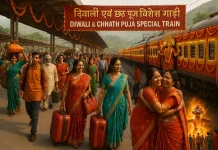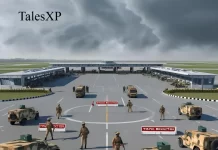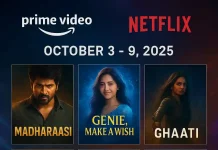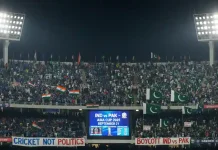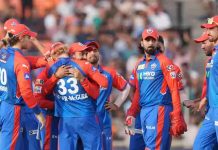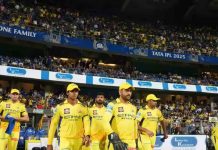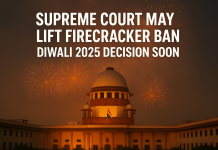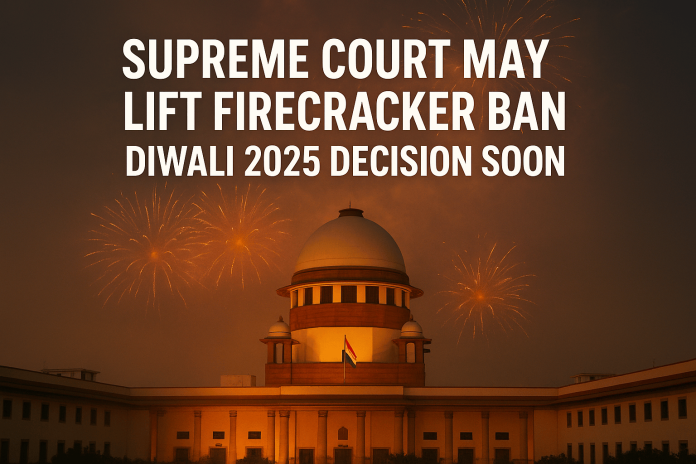As Diwali 2025 approaches, a major development is unfolding that could change the way Delhi-NCR celebrates the festival of lights. The Supreme Court of India is reportedly considering lifting the blanket ban on firecrackers imposed in the recent years due to severe air pollution concerns. The move has sparked a nationwide debate — between those who see it as a long-awaited relief for small traders and those warning of worsening air quality.
With the capital already struggling to maintain clean air during winter months, the Court’s decision could have far-reaching environmental, social, and economic implications.
Why the Ban Was Imposed
The story of the firecracker ban in Delhi-NCR dates back to 2017, when the Supreme Court first intervened to tackle the alarming rise in air pollution. After several studies revealed a direct link between post-Diwali smog and firecracker emissions, the Court banned the sale and use of traditional firecrackers, allowing only “green crackers” approved by the Council of Scientific and Industrial Research (CSIR).
Despite these restrictions, implementation was often inconsistent. Many residents continued to burst crackers, while traders complained of heavy losses due to unclear guidelines and limited availability of eco-friendly alternatives.
Why the Supreme Court Is Reconsidering in 2025
According to reports, multiple petitions have been filed by firecracker manufacturers and traders’ associations urging the Supreme Court to review the total ban, citing severe economic distress and lack of clarity in enforcement.
The Court’s decision to reopen the discussion ahead of Diwali 2025 is seen as a response to these pleas. Sources suggest that the bench is considering a conditional relaxation of the ban, which might include allowing “certified green crackers” under strict monitoring and within specific time slots.
A senior advocate representing the traders reportedly argued,
“The livelihood of thousands depends on this industry. A complete ban without alternatives violates their right to trade under Article 19(1)(g) of the Constitution.”
Delhi’s Pollution Paradox
Delhi-NCR’s pollution problem is complex and multi-sourced. Every winter, the air quality index (AQI) plunges to “severe” levels, primarily due to stubble burning, vehicular emissions, industrial waste, and weather conditions that trap pollutants near the ground.
However, firecrackers have become a symbolic trigger for public outrage and media headlines during Diwali. Environmental experts note that while crackers may not be the sole cause, they intensify short-term pollution and cause a sudden spike in PM2.5 and PM10 levels.
Data from the Central Pollution Control Board (CPCB) shows that during Diwali 2023 and 2024, particulate matter levels in Delhi doubled overnight following cracker use, despite bans.
Public Reaction: Divided Opinions
As news of the Supreme Court’s potential review spreads, reactions have been deeply divided.
- Traders and shop owners in places like Sadar Bazaar and Faridabad welcomed the possibility of the ban being lifted, calling it a “return of livelihood after years of loss.”
- Environmentalists and health experts, however, have voiced strong opposition, warning that it could undo years of progress in pollution control.
Ramesh Kumar, a firecracker trader from Delhi, said:
“For seven years, we’ve faced financial ruin. Many of us had to switch jobs. If the Court allows licensed sales again, it will bring back hope for thousands of families.”
On the other hand, Dr. Aruna Mehta, a pulmonologist at AIIMS, expressed concern:
“Even short exposure to high pollution levels can trigger asthma attacks and respiratory issues, especially in children and the elderly. Allowing crackers again could be catastrophic.”
The Rise of Green Crackers: A Possible Middle Path
In 2018, the CSIR introduced the concept of “green crackers”, which release fewer pollutants and use safer chemicals. These include types like SWAS (Safe Water Releaser), STAR (Safe Thermite Cracker), and SAFAL (Safe Minimal Aluminum).
Green crackers are designed to reduce particulate emissions by up to 30%, and they don’t contain harmful substances like barium nitrate. The Supreme Court may choose to allow only these certified variants, with strict packaging and sale monitoring.
However, enforcement remains a challenge. In past years, counterfeit products were sold under the “green cracker” label, confusing consumers and undermining regulation.
State Governments’ Stance
Delhi’s Environment Minister has maintained that public health will remain the top priority, regardless of the Court’s decision. If the Supreme Court lifts the ban, the final implementation could still vary across states.
Neighboring states like Haryana, Uttar Pradesh, and Rajasthan often mirror Delhi’s policies due to shared air quality issues. However, local enforcement and political pressures might lead to differences.
In previous years:
- Delhi imposed complete bans during “severe” AQI periods.
- Haryana allowed time-restricted bursting of crackers in certain areas.
- Uttar Pradesh permitted green crackers under license.
This year, state coordination will be crucial to prevent cross-border cracker smuggling and uneven air quality outcomes.
Economic Impact: The Trade and Employment Angle
India’s fireworks industry is centered in Sivakasi, Tamil Nadu, which accounts for nearly 90% of the country’s firecracker production. The industry employs around 3–4 lakh workers directly and supports another 5 lakh indirectly.
Over the last few years, orders from Delhi-NCR and major northern cities declined drastically, leading to massive job losses. A partial or full lifting of the ban could revive the industry — though experts say it must be balanced with environmental responsibility.
Industry leaders have assured the Court that they are ready to comply with safety and emission norms if allowed to resume production and distribution under clear rules.
Health and Environmental Experts Warn of Consequences
Medical professionals and environmental organizations like Greenpeace India and CSE (Centre for Science and Environment) have submitted data to the Court highlighting the short-term health hazards linked to cracker pollution.
During Diwali, Delhi’s pollution levels often surge by 40–50% overnight. Doctors report increased cases of:
- Breathlessness
- Eye irritation
- Chest infections
- Worsened asthma and COPD symptoms
If the Court lifts the ban without safeguards, they warn, hospitals could once again see a seasonal spike in respiratory cases, particularly among children and the elderly.
Technology and Enforcement: Can It Be Controlled?
If the Supreme Court allows limited use of crackers, real-time enforcement will be the key challenge. Experts suggest using drone surveillance, CCTV, and mobile reporting apps to monitor illegal sales and large-scale violations.
In addition, AI-based air quality tracking could be employed to identify pollution spikes and attribute them to cracker usage. Citizens could also play a role through awareness campaigns and community-based monitoring.
Citizens’ Voices: Tradition vs. Responsibility
The debate isn’t just legal or environmental — it’s cultural. For millions of Indians, bursting crackers is deeply associated with Diwali celebrations. For others, it represents an avoidable environmental and health hazard.
Social media platforms are already witnessing heated discussions. Hashtags like #LetUsCelebrate, #SayNoToCrackers, and #GreenDiwali2025 are trending as users express mixed feelings about the possible rollback of restrictions.
A Delhi resident wrote on X (formerly Twitter):
“I love crackers, but I also love breathing clean air. If there’s a way to celebrate responsibly, I’m all for it.”
What Happens Next
The Supreme Court is expected to deliver its verdict soon, possibly before the end of October 2025. If the bench decides to partially lift the ban, new guidelines for cracker sales, bursting hours, and emission testing will be issued.
Experts anticipate:
- Crackers allowed only during specific hours (e.g., 8 PM to 10 PM on Diwali night).
- Mandatory use of licensed green crackers.
- Fines or arrests for selling or using banned variants.
The Delhi Pollution Control Committee (DPCC) and state agencies will then determine how to implement the judgment locally.
Conclusion: Balancing Joy and Responsibility
The Supreme Court’s potential move to lift or relax the firecracker ban in Delhi-NCR for Diwali 2025 could redefine the festival’s celebrations — and its environmental cost. While traders and manufacturers may find hope in economic revival, the challenge lies in ensuring responsible celebration without endangering public health.
India’s path forward may depend on embracing innovation — using eco-friendly alternatives, community awareness, and strong enforcement — to strike a balance between tradition and sustainability.
Whether the skies over Delhi will light up with fireworks this Diwali, or remain quiet in the name of cleaner air, will soon be decided in the country’s highest court.

